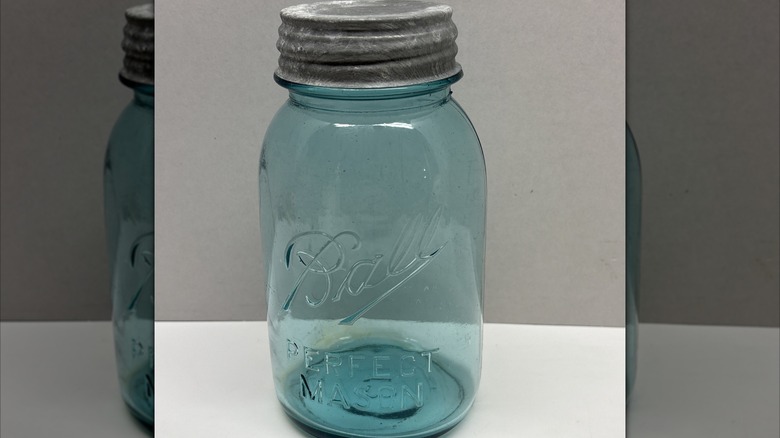The Number On Vintage Mason Jars That Makes Them More Valuable
You've probably seen plenty of Mason jars at flea markets and yard sales and perhaps the occasional antique store. Perhaps you think that would look pretty on your kitchen counter, especially with some fresh cut flowers. Or maybe you'd actually use it for its original intended purpose — storing food — and tuck it away in the pantry. But you look at the price tag and wonder what the vendor was thinking. After all, aren't Ball Mason jars a dime a dozen? Not exactly. If you're fortunate enough to stumble on one that's been marked at the bottom with the number 13 –- and in this case the number 13 is particularly lucky –- you may have hit the Mason jar jackpot.
Antique Ball Mason jars commonly have a number at the bottom of the jar. Although people often believe the numbers indicate when the jar was made, they actually refer to the mold used for that particular jar and where it was placed on the glassmaking machine. Each machine had a series of eight to 10 molds, all making the same type of jar. If a bad jar was produced, it was easy to know which mold needed to be replaced.
How number 13 jars became rare -– and therefore more valuable –- is the stuff of legend. Moonshiners operating during the prohibition period used Ball's glassware to transport their illegal goods. A superstitious lot, the moonshiners not only wouldn't use jars with the number 13 on them, they destroyed them, afraid that using one, even by accident, would bring bad luck in the form of the police raining down on them.
How to tell is a Ball mason jar is valuable
The true story behind the rarity of jars with the number 13 is less dramatic. Since there were only eight to 10 molds on the glassmaking machine at a time, molds above the number 10 were used only if they were replacing another mold. If you come across a number 13, you are in a bit of luck, just not the kind you'd have gotten if you found a Rembrandt fetching $1.4 million in your attic. You can find several number 13 jars on eBay, with prices ranging from $25 to $814. The value of the jar depends on its age (which you can tell from its logo), the color of the glass (blue is common), the presence of imperfections (the more the better), and the number inside the lid (if you have a double 13, you're still not in Rembrandt territory but you will get more for the jar).
Mason jars have been having a moment of late, but when they were invented by John Landis Mason in 1858, they were a necessity, crucial for helping people can and store fruits and vegetables for the fall and winter. More than 20 years later, the Ball Company, which made wood-jacketed tin cans for paint, kerosene, and other chemicals, licensed the design from Mason and began manufacturing the glass jars. Today, there are a number of hacks using the glass vessels that will take your dishes to the next level. Martha Stewart uses them for make-ahead composed salads that are as beautiful as they are convenient, especially since they can keep lettuce from wilting.


